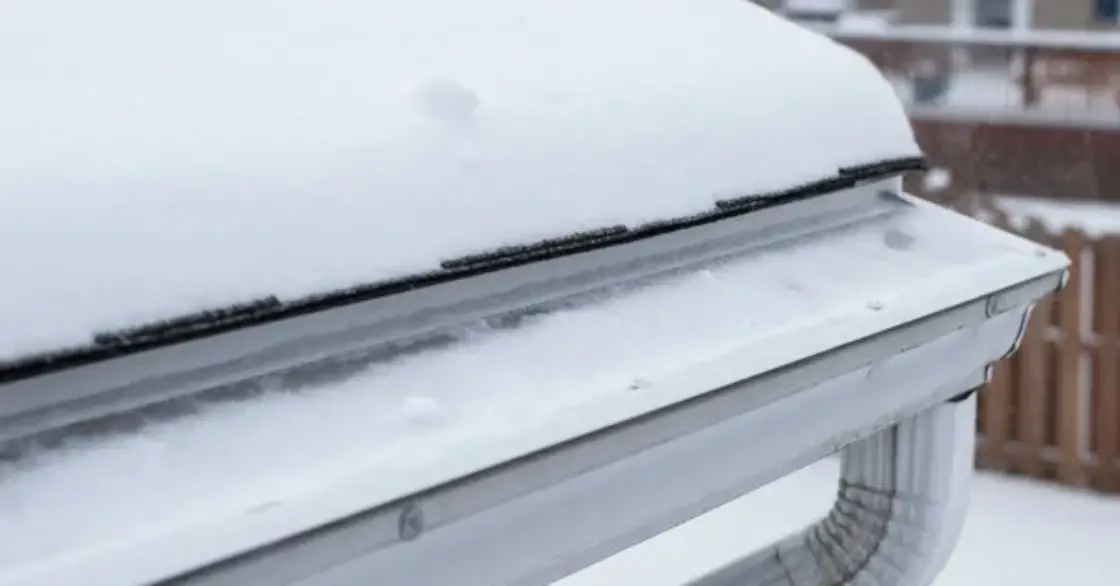Do Gutter Guards Cause Ice Dams on Roofs?

You were planning on getting gutter guards for your home. You were excited about it because you chose quality gutter guards that would reduce or eliminate the need for frequent gutter cleanings.
Finally, you thought to yourself. I won’t have to check my gutter guards all the time for clogs!
But then you saw something on the internet that gave you pause. A blog post in a Google search or maybe a comment on social media.
It may have said something like this: “Beware gutter guards. They cause ice dams!”
Huh?
You did a double-take. You read it again. Then you wondered: “Can gutter guards cause ice dams on roofs?”
And if so, does that mean you shouldn’t get them? Read on to learn more.
In this article:
- What Are Ice Dams?
- How Can I Tell If My House Has Ice Dams?
- Why Do Ice Dams Form In the First Place?
- The Truth about Gutter Guards and Ice Dams
- Poor Quality Gutter Guards Can Exacerbate Ice Damming
- What Kind of Gutter System Is Best for Winter Weather?
- How Do I Prevent Ice Dams from Forming?
- Frequently Asked Questions
What Are Ice Dams?
An ice dam is a ridge of ice that forms at the edge of a roof. As it grows, it can prevent water from properly draining off the roof.
Ice dams are most common in northern climates where heavy snow occurs. If an ice dam is present through much of the winter season, as the ice melts, the water can make its way into cracks and openings in the roof, eventually even leaking into the attic.
If it’s not addressed, an ice dam can cause damage to a home’s walls, ceilings, and insulation.
How Can I Tell If My House Has Ice Dams?
Because you’re on the ground looking up at your roof, it’s not always easy to tell if you have an ice dam. There are other signs, however, that you can watch for:
- Visible ice or water on your home’s siding
- Icicles or ice buildup along your roof’s edge or behind the gutters
- Water or ice inside or around the window frames
- Ice coming out of any exterior vents along the roof
- Basement flooding
- Sheetrock water stains
If you see any of these signs, you likely have an ice dam and need to address it right away to prevent damage to your home.
Why Do Ice Dams Form In the First Place?
Ice dams get started because of uneven temperatures on the roof. These may exist simply because of normal indoor heating and outdoor sun exposure, or because of poor attic insulation and/or poor ventilation.
The process goes like this: Indoor heat rises to the attic and warms up exposed portions of the roof. In those areas, snow melts. Once it’s changed to a liquid, it runs down the roof until it gets to the roof’s edge.
There, the temperatures are typically colder for several reasons:
- indoor heat doesn’t reach the edge of the roof as efficiently
- the overhang of the roof is not heated at all
- portions of the roof’s edge sit in shade for much of the day, out of range of direct sunlight, so they don’t warm up as much as some of the upper portions of the roof
If you live in an area that gets a lot of snow, your home is more vulnerable to ice dams because of the snow buildup on the roof.
The Truth about Gutter Guards and Ice Dams
High-quality gutter guards help you safeguard the investment in your home. They prevent clogs from forming inside your gutters so you can avoid problems like leaking, structural damage, and mold and mildew buildup caused by clogged gutters.
However, if you live in an area prone to ice dams, your gutter guards may form the foundation for those dams. The gutter guards themselves won’t cause the ice dams—those ice dams would form either way—but if the gutter guards are there, that’s where the ice dam could end up.
As the snow melts and rolls down the roof, it may gather on top of the gutter guard, freeze, and limit the gutter’s ability to shed additional water from the melting snow. Without attention, the gutter can become weighed down by the ice dam, which may damage or even cause it to pull away from the home.
Poor Quality Gutter Guards Can Exacerbate Ice Damming
There are several steps you can take to help prevent ice dams from forming while still enjoying the benefits of gutter guards.
The first is to choose the right gutter guards. Low-quality gutter guards that aren’t as good at preventing clogs are more likely to work against you in winter.
That’s because a clogged gutter will not let the melting snow drain off the roof. It already has leaves and debris inside it, so the melted snow settles and freezes, exacerbating the ice-damming process. You can help yourself by cleaning out your gutters in late fall before winter begins.
The cheap metal DIY screens available from home improvement stores also perform poorly in areas that get a lot of snow in winter. Low temperatures can cause these types of guards to freeze over quickly, so they form a solid wall inside the gutter rather than allowing water to flow through.
Gutter guards that have a lower slope than the roof itself—without any sort of pitch—will have similar problems. The melting snow will drain down, hit the level gutter guard, sit there, and freeze.
Weak gutter guards and gutters are more likely to buckle under the weight of ice buildup. They could break or separate from the roof, perhaps even causing damage to the roof as they do so.
To avoid these sorts of issues, choose a gutter system that has been designed with winter in mind.
What Kind of Gutter System Is Best for Winter Weather?
When looking for a gutter system that will better manage the winter weather, look for the following characteristics in both your gutters and gutter guards:
- Wide gutters: These help spread the snow and melting water over wider widths, encouraging draining. They also channel larger volumes of water.
- Steel gutters: Steel is the best material for gutters that need to withstand winter weather, as they can better withstand the weight of the ice and snow while resisting warping.
- Mesh guards: These help filter out debris, preventing clogs from forming inside your gutters and allowing water to flow through.
LeafFilter Gutter Protection helps keep your gutters free of debris so water can continue to flow away from your home. For example, our gutter guards will not only block leaves but also prevent smaller debris—such as shingle grit, pine needles, and pollen—from passing through and potentially clogging your gutters.
Our patented gutter guards also eliminate the need to clean out the gutters, so you can rest easy in the winter season knowing that your gutter system is working properly.
Did you know that LeafFilter's micro-mesh screen is made of surgical-grade stainless steel? 💪 This material can withstand the toughest weather and the heaviest debris. Get the facts at https://t.co/rsIPpXXKiS #LeafFilter #HeavyDuty #DurableMaterials pic.twitter.com/VEw95qLhw1
— LeafFilter Gutter Protection (@LeafFilter) June 14, 2023
Our gutter guards are professionally installed with internal hidden hangers, which provide the critical strength your gutter guards need to handle snow and ice. Our award-winning gutter system is made of a stainless steel material that offers superior durability for an extended lifespan, and it’s pitched so that it slopes away from the roof, making it more difficult for water to pool and freeze.
Better yet, we offer a transferable lifetime warranty, giving you peace of mind that your gutters will perform as they should.
How Do I Prevent Ice Dams from Forming?
To help prevent ice dams from forming in the first place, consider taking these steps:
- Clean out your gutters: Make sure your gutters are free of leaves, sticks, and other debris before winter. (If you have gutter guards installed, you can skip this step.)
- Check your attic insulation: Ensure your attic insulation is properly installed to help eliminate hot spots on your roof.
- Consider a metal roof: Metal roofs help prevent snow from settling and freezing. They are better at shedding large amounts of snow in colder climates.
- Brush off excess snow: If you can reach your gutters, brushing excess snow off can help minimize the risk of ice formation. If you get a lot of snow, it may be worth it to pay a professional to clear the roof.
Frequently Asked Questions
Do gutter guards protect against ice dams?
Gutter guards will not stop ice dams from forming, but some will manage the snow and ice better than others. Micromesh gutter guards are designed to withstand the weight of snow and ice while keeping water flowing freely through your gutters.
Do gutter guards cause problems in the winter?
Gutter guards are not the primary cause for ice dams or ice buildup. They can, however, form a foundation for the ice dam, particularly if they are clogged. Cleaning out your gutters before winter can help, as can installing a gutter guard system.
What can I put on my roof to prevent ice dams?
Most home improvement stores carry roof de-icing cables, which can be installed on top of your roof’s shingles or clipped over the eaves. They won’t completely prevent ice dams from forming, but they can help provide space for water to run off into the gutter. However, these cables run on electricity, so they will increase your energy bill.
It’s best not to use rock salt or roof melt tablets as they contain ingredients that may damage your roof.
How do you get rid of ice dams fast?
Climbing up onto your roof or onto a ladder in the winter is dangerous. If you have an ice dam that you believe may be causing damage, we recommend calling a professional to remove it.


